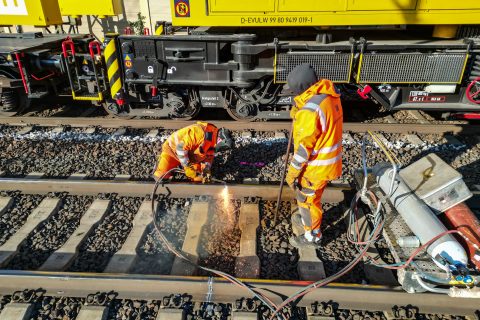Even more construction on German tracks this year to replace half a million sleepers

The German railway network will have 400 additional construction sites this year and this will have a negative impact on punctuality, predicts Deutsche Bahn. DB will replace more than five times more sleepers than usual. This decision was taken just before a report confirmed that defective concrete sleepers were the cause of the accident in Garmisch-Partenkirchen last year.
Deutsche Bahn (DB) is replacing a total of around 480,000 sleepers this year. Typically, around 80,000 sleepers are renewed each year. After initial suspicion of a possible manufacturing defect as the cause of last year’s accident, where 5 people lost their lives, DB identified where else concrete sleepers with the same rock mixture had been used.
On Thursday 1 June, the suspicion that faulty sleepers were the cause of the accident was confirmed. Germany’s federal rail accident investigation unit BEU published its initial findings into the fatal derailment that happened on June 3 last year. There is a manufacturing error in the concrete sleepers, that are the basis of a large part of the network. The replacement, however costly, is thus necessary. At the same time, the replacements come on top of the already extensive construction works on the German tracks.
‘Precautionary replacements’
A a special inspection programme was initiated for concrete sleepers, and as a “very precautionary measure”, sleepers with any abnormalities are replaced, the German railway company said. DB has also set up a group of internal and external experts to continuously check possible further preventive measures for the maintenance of concrete sleepers.
“We will replace the affected sleepers as soon as possible, an immense feat”, says DB spokesperson. “Specialist staff and construction machines are scarce given our other construction workload. It will be a while before all affected sleepers have been replaced nationwide – at least into next year. We ask all travelers and freight customers for their understanding of the restrictions.”
Trains can only run at a lower speed in the affected sections of track until the replacement. In some cases, DB has to close routes even before the actual construction work begins. Inspection and replacement of sleepers therefore have a clearly negative effect on punctuality in long-distance and regional transport, warns the German railway company.
The accident
On 3 June 2022, a double-decker passenger train derailed near the southern German town of Garmisch-Partenkirchen. This resulted in the death of 5 people and 16 injured. German media quickly uncovered that the section where the accident happened was slated to undergo track replacement works later that month. In July 2022, DB then embarked on a precautionary inspection campaign of concrete sleepers similar to those used on the tracks near Garmisch-Partenkirchen. At the time, the company said it was not jumping to the conclusion that the sleepers were possibly at fault.
It was not until mid-August that independent testing institutes in Germany said that they had possibly uncovered a manufacturing error in the concrete sleepers identical- in terms of rock mixture – to the ones also used in the tracks near the site of the accident.
The inspection campaign was subsequently widened, and DB back then said the resulting financial damage would end up in the hundreds of millions. This sum has probably increased since then. On Wednesday 31 May, DB said it would be replacing around 480,000 sleepers this year whereas typically some 80,000 sleepers are renewed each year.
This article was originally published on our sister publication RailTech.com.





